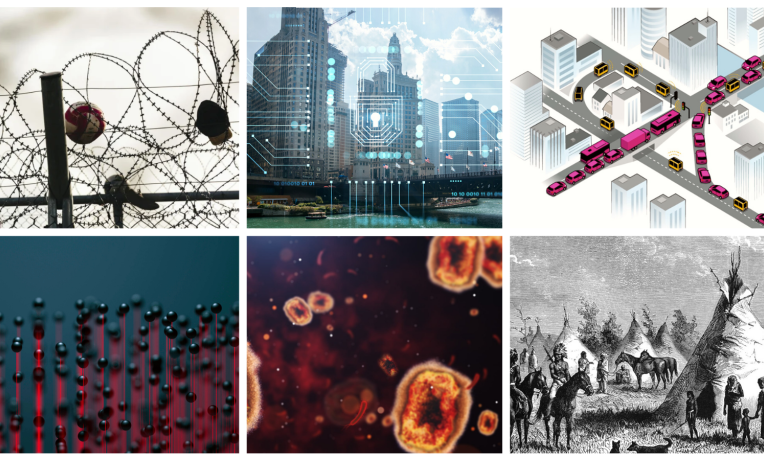ERC Starting Grants 2022 - project highlights

How courts of justice are shaping access to asylum

The number of asylum seekers is at a historical high and is likely to increase further over the next decade. Nevertheless, access to asylum is limited by similar barriers being developed by States across the globe, such as push and pull-backs, walls and fences, border detention centres and externalisation of asylum processing. This threatens the entire global refugee system, which cannot function in the absence of effective access to asylum.
The 1951 UN Convention Relating to the Status of Refugees, also known as the Refugee Convention, is a United Nations multilateral treaty that sets out the responsibilities of States to protect refugees. In the absence of a global court ensuring uniform, legally binding interpretation of the conformity of the aforementioned barriers with the Refugee Convention, the legality of these barriers is decided by domestic and supranational courts across the globe.
A new research programme seeks to understand if courts around the globe have systematically yielded similar or different interpretations on the compatibility of State-developed barriers with the Refugee Convention.
Taking a comparative socio-legal approach, Madalina Moraru and her team will analyse the role of courts in interpreting the right to asylum. The focus will be on identifying discernible patterns in the courts’ decisions related to barriers to asylum (whether judgments contribute to restricting or expanding access to asylum), the socio-legal factors influencing courts’ decision-making, and on how courts have developed international refugee law in response to these barriers.
- Researcher: Madalina (Bianca) Moraru
- Project: Gatekeepers to International Refugee Law? – The Role of Courts in Shaping Access to Asylum (ACCESS)
- Host Institution: Masaryk University, the Czech Republic
- ERC grant: 1.49 million euro for 5 years
Quid pro quo for American chews

Palaeogenomics has revolutionised our understanding of human history at the biological and sociocultural level by analysing thousands of ancient human genomes sequenced from skeletal remains. Unfortunately, this approach requires destructive sampling of the skeletal remains, and thus can often be in conflict with the values of descendant communities such as the indigenous peoples of the Americas.
New research will avoid this problem by using a novel DNA source: ancient quids. Quids are man-made wads of chewed up plant fibre that are recovered from archaeological sites. In contrast to skeletal remains, quids are abundant in American archaeological records. José Víctor Moreno Mayar and his research team will use quid DNA to reconstruct the evolutionary history of the indigenous peoples, in a continent where human evolutionary history is understudied, skeletal remains are rare, and the destructive sampling of such remains is difficult.
Similar to a mouth swab, an ancient quid contains traces of the chewer's, their oral microbiome's and the chewer's meals' DNA, as well as that of the plants used in the “chew” itself. Quid DNA can be used to track human population history, dietary and microbiome shifts, pathogen prevalence and their interplay through time.
The research team will reconstruct the genomic history of Indigenous Americans, their past lifestyles and subsistence strategies, their health, and how these influenced each other. The focus will be on three major historical transitions: the initial rapid peopling by hunter-gatherers, the emergence of complex agricultural societies, and their demise during European colonisation.
- Researcher: José Víctor Moreno Mayar
- Project: Tracing Indigenous American genomic history, subsistence strategies, health and their interplay through time using DNA from ancient masticated plant fibres (QUIDS)
- Host institution: University of Copenhagen, Denmark
- ERC grant: 1.49 million euro for 5 years
Cryptography: can theory and practice combine to beat “side-channel” attacks?

Cryptography is everywhere in our daily life. It ensures the confidentiality and authentication of our communications and guarantees the integrity of our records and documents. However, its implementation on embedded devices such as ATM machines, routers and cell phones represents a serious security challenge.
There are two types of attacks against these kinds of devices: black-box attacks, which are based on the device’s input-output behaviours; and side-channel attacks, which additionally exploit the physical leakage released by the device, e.g., power consumption. While the former are more standard and their prevention is more well-established, the latter may as well yield tremendous damage within seconds.
Proposals for countermeasures to such attacks come both from the practical and the applied communities, but what Sonia Belaïd proposes is to combine the advantages of both approaches: together with her team from the Parisian company CryptoExperts, her innovative idea is to provide a high-level security model - following the theorists’ approach - but without sacrificing usability and efficiency – in accordance with practitioners priority.
Her ambitious project may lead to a significant breakthrough in this area, with the development of usable tools for designing provably-secure cryptographic implementations in realistic models.
- Researcher: Sonia Belaïd
- Project: Generation and Verification of Masking Countermeasures Against Side-Channel Attacks (AMAskZONE)
- Host institution: CryptoExperts, France
- ERC grant: 1.49 million euro for 5 years
Unveiling the peculiarities of natural systems

Major challenges require unravelling the secret mechanisms of nature. To contrast epidemics, fight antibiotic resistance, devise new therapies and biotechnologies, we must understand complex behaviours that natural systems are able to preserve with astounding robustness, despite huge uncertainties and parameter variations.
Two approaches have attempted to tackle this issue so far: parameter-dependent simulations that predict the system behaviour case by case; parameter-free structural methods that check whether the system preserves a special behaviour exclusively due to its interconnection structure, as often happens in nature.
To go beyond the limitations of each of these approaches, Giulia Giordano will integrate them for the first time ever, so as to create a novel mathematical theory and algorithms to analyse and control complex, uncertain dynamical systems in biology and epidemiology.
Which system features can enable or prevent a property? Which key parameters must be finely tuned to enforce it? Can we identify the best targets for interventions aimed at inducing a desired behaviour? Dr. Giordano will develop methodologies to answer these questions, tailored to the peculiarities of natural systems, which will offer a deeper insight into natural mechanisms and help us identify therapeutic targets for healing diseases, design biological systems with guaranteed properties, predict and control epidemics.
- Researcher: Giulia Giordano
- Project: Integrated Structural and Probabilistic Approaches for Biological and Epidemiological Systems (INSPIRE)
- Host institution: University of Trento, Italy
- ERC grant: 1.5 million euro for 5 years
Breaking the impasse in anti-parasite vaccine development

Malaria and other parasitic diseases kill or injure millions of people around the word, especially in poor countries. What could help alleviate the burden of these disease and their economic impact are vaccines. Yet, there are almost no anti-parasitic vaccines licenced for human use. Parasites have many lifecycle stages, intricate strategies to evade immune response, and often use intermediate hosts e.g. mosquitoes. However, research on animals shows that vaccination with weakened parasites is an effective strategy to induce immunity to parasites.
Meta Roestenberg and her team at the Leiden University Medical Center have recently translated attenuated parasite vaccination to humans in proof-of-concept clinical trials. The unique preliminary data collected in the process indicated the role for the skin as a prime immunological organ and a preferred site of vaccination. Based on these findings, Prof Roestenberg proposes to create a next generation of highly effective vaccines, ready for pre-clinical testing. The research, if successful, may break the impasse in the field of parasite vaccines development and provide new tools and approaches in vaccinology.
- Researcher: Meta Roestenberg
- Project: Dissecting early Skin-based immune responses to PARasites in ControLled human infection studies to design novel vaccines (SPARCL)
- Host institution: Leiden University Medical Center, Netherlands
- ERC grant: 1.49 million euro for 5 years
Playing urban mobility games with intelligent machines

Artificial intelligence has outperformed humans in the most complex games. It is also likely to win the urban mobility games, beating us to arrive faster or reduce costs. As a result, it would be tempting to gradually hand over our decisions to intelligent machines. The consequences of this ongoing revolution are challenging to predict. From autonomous vehicles to fleet management, many studies show the positive potential of AI in urban mobility. Yet, negative impacts are often overlooked.
Rafal Kucharski will embark on an interdisciplinary expedition inside the virtual urban mobility environment, where machines and humans play the game for limited resources. He will create four games to explore the conflict scenarios. Based on these findings, he will propose a multi-objective reinforcement learning framework, where machines learn to reduce conflicts while simultaneously reaching their inherently selfish objectives.
- Researcher: Rafal Kucharski
- Project: Playing urban mobility games with intelligent machines. Framework to discover and mitigate human- machine conflicts. (COeXISTENCE)
- Host institution: Uniwersytet Jagiellonski, Poland
- ERC grant: 1.49 million euro for 5 years





